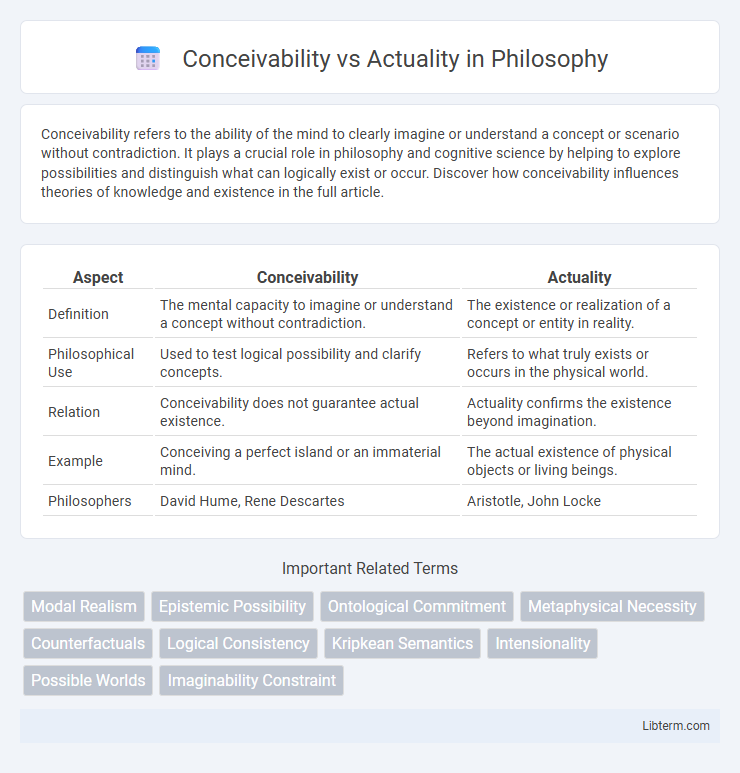Conceivability refers to the ability of the mind to clearly imagine or understand a concept or scenario without contradiction. It plays a crucial role in philosophy and cognitive science by helping to explore possibilities and distinguish what can logically exist or occur. Discover how conceivability influences theories of knowledge and existence in the full article.
Table of Comparison
| Aspect | Conceivability | Actuality |
|---|---|---|
| Definition | The mental capacity to imagine or understand a concept without contradiction. | The existence or realization of a concept or entity in reality. |
| Philosophical Use | Used to test logical possibility and clarify concepts. | Refers to what truly exists or occurs in the physical world. |
| Relation | Conceivability does not guarantee actual existence. | Actuality confirms the existence beyond imagination. |
| Example | Conceiving a perfect island or an immaterial mind. | The actual existence of physical objects or living beings. |
| Philosophers | David Hume, Rene Descartes | Aristotle, John Locke |
Understanding Conceivability: Definition and Scope
Understanding conceivability involves recognizing it as the mental ability to imagine or conceive a scenario without contradiction, highlighting its role in epistemology and philosophy of mind. The scope of conceivability extends to distinguishing between what can be coherently thought of versus what is metaphysically or empirically actual, emphasizing the boundary between imagination and reality. This distinction informs debates on the nature of existence, possibility, and the limits of human cognition.
What Is Actuality? Exploring the Concept
Actuality refers to the state of existing in reality as opposed to merely being possible or imagined; it is the realization of potential into concrete existence. In philosophy, actuality is often contrasted with potentiality, highlighting the difference between what could be and what is. This concept is fundamental in metaphysics and ontology for understanding how possibilities are manifested in the material world.
The Historical Roots of Conceivability vs Actuality
The historical roots of conceivability versus actuality trace back to early metaphysical inquiries by philosophers such as Aristotle, who distinguished between potentiality and actuality as fundamental modes of being. Medieval scholastics like Thomas Aquinas expanded these concepts to explore the nature of existence and essence, emphasizing that conceivability does not guarantee actual existence. The Enlightenment further developed this distinction through thinkers like Descartes, who argued that some ideas are conceivable yet may not correspond with actual entities, solidifying the philosophical debate surrounding the limits of human cognition and reality.
Philosophical Perspectives on Conceivable vs Actual
Philosophical perspectives on conceivability versus actuality explore the relationship between what can be imagined or conceived and what actually exists or is possible in reality. Modal epistemology examines conceivability as a guide to possibility, while metaphysical discussions address whether all conceivable entities correspond to actual ones or merely to potential states. Debates often center on whether conceivability implies metaphysical possibility, as in Descartes' dualism or Kripke's necessity of identity, highlighting the distinction between mental constructs and ontological facts.
Conceivability as a Test for Possibility
Conceivability as a test for possibility hinges on the notion that if something can be coherently imagined without contradiction, it is conceptually possible. Philosophers like Descartes argue that clear and distinct conceivability provides prima facie evidence for metaphysical possibility, distinguishing between what can exist in reality and what is merely imaginable. However, critics highlight that conceivability does not always guarantee actual possibility due to limits in human understanding and potential unknown necessary conditions.
Real-World Examples: When Conceivable Isn’t Actual
In philosophy, conceivability refers to the ability to imagine a scenario as possible, while actuality requires the scenario to exist in reality. For example, it is conceivable to imagine a world without gravity, yet gravity is an actual and indispensable force governing physical interactions on Earth. Similarly, the concept of a technologically advanced society colonizing Mars is conceivable, but as of 2024, actual human colonization remains unrealized despite ongoing space missions.
Limits of Human Imagination and Actuality
The limits of human imagination constrain conceivability, as some concepts remain beyond cognitive reach despite being logically possible. Actuality grounds these concepts by manifesting only what exists or can exist within physical and metaphysical laws, distinguishing real possibilities from mere imaginative constructs. This distinction underscores that conceivability does not guarantee actuality, highlighting the boundaries between thought and existence.
Conceivability Fallacies: Mistaking Imagination for Reality
Conceivability fallacies occur when individuals mistake what is imaginable or logically conceivable for what is actually possible or real, leading to flawed conclusions. This error often arises in philosophical arguments and thought experiments when a scenario that can be conceived without contradiction is assumed to exist or be feasible in reality. Distinguishing between conceivability and actuality requires rigorous empirical verification rather than relying solely on intuitive or conceptual reasoning.
Implications in Science and Metaphysics
Conceivability versus actuality plays a crucial role in both science and metaphysics by guiding the limits of what can be imagined compared to what physically exists or can occur. In science, conceivability aids in hypothesis generation and theoretical modeling, while actuality anchors these ideas to empirical evidence and observable phenomena. Metaphysically, the distinction raises questions about the nature of existence and possibility, influencing debates on whether conceivably possible entities or worlds have any ontological status or causal power.
Bridging Conceivability and Actuality: Final Thoughts
Bridging conceivability and actuality requires analyzing the logical coherence of ideas alongside empirical validation to determine their real-world existence. Philosophical arguments often emphasize the distinction between what can be conceived without contradiction and what actually exists in reality. This approach underscores the necessity of integrating conceptual clarity with observational evidence to resolve debates surrounding metaphysical possibility and ontological commitment.
Conceivability Infographic

 libterm.com
libterm.com